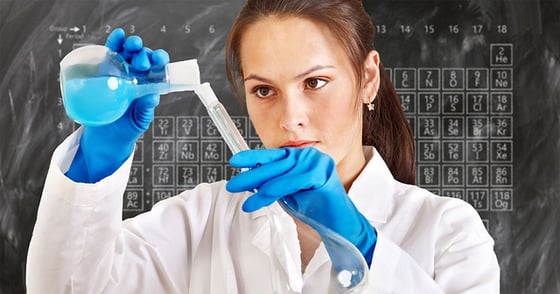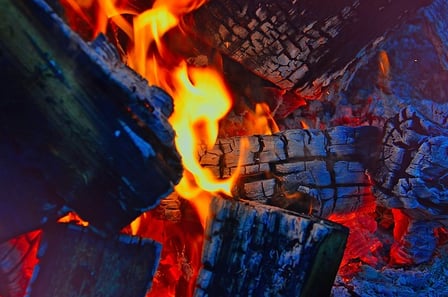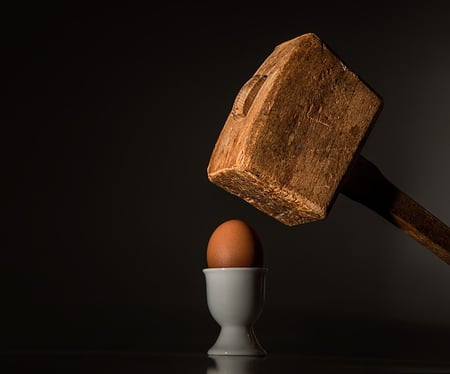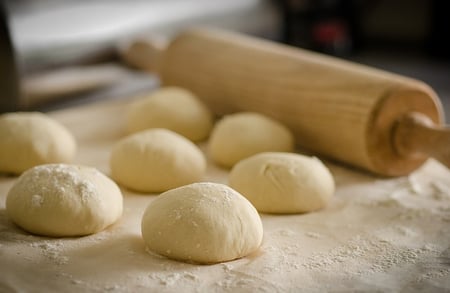Is A Animals Physical Or Chemical Change
In your science class, you may accept heard of chemic and physical changes. Just do you know how to tell the difference betwixt the two? The answer lies in whether or not a modify to a substance results in its molecules being rearranged. In this article, we will define chemical and concrete and changes. And then nosotros'll take a look at specific chemical change examples and physical alter examples to improve understand their differences and similarities. So let'due south get started! When ice cream melts (and goes from a solid to a liquid), information technology undergoes a physical change. First, permit'south talk about physical changes in chemistry. A physical change occurs when a substance or object changes its appearance, phase, or is used in a mixture. More importantly, a physical change does not change the molecular structure of a substance. And you can reverse a physical modify to recover all of the original matter, even if it doesn't look exactly the same. In other words, in physical changes, the molecules from earlier and after the alter stay the same! What is an case of a physical change? Things similar cutting a slice of paper in half, freezing h2o into ice or bending some of your mom's favorite silverware (don't exercise that!) are all physical changes. That'south because concrete changes only affect a substance's concrete backdrop, non the composition of their molecules. Still not certain about what constitutes a physical change? Don't worry: we'll dig into more physical alter examples in just a minute. When logs burn down, they undergo a chemical alter. In contrast, a chemical change takes place when the original substance'south of molecules are taken apart and put dorsum together into new combinations that are dissimilar from the original combinations. Furthermore, the original matter cannot exist recovered. And unlike concrete changes, these changes ordinarily apply a lot more energy, such equally heat and low-cal, considering the molecular bonds demand to be broken in order to rearrange them. What is an example of a chemical modify, then? Some chemical alter examples include a piece of paper burning, a nail rusting, or baking a cake. Like physical changes, it'south pretty articulate that the way these things showtime and end are quite dissimilar: a shiny blast turns orange with rust, and wet dough becomes a delicious dessert. The reasons these are chemical changes is that the change happens on a molecular level. Put another way, the object yous begin with and the object you end with are completely different substances. And then, let's look at some more examples of concrete and chemic changes to ameliorate understand the differences and similarities between the two. When this mallet hits the egg, the egg will undergo a (very messy) concrete change. (P.South: Don't attempt this at home!) Earlier we talked about some examples of concrete and chemical changes. But sometimes telling a physical change from a chemical change tin be hard. This is especially true when physical changes require or expend energy. The important thing to remember is that in a physical change, the molecules remain the same. Allow'southward look at three unlike concrete change examples to better understand this idea. Phase changes involve changes in size, volume, and density. For case, when y'all turn water into ice or vapor, this is called a phase change. This is considering water has 3 phases: solid (ice), liquid (water), and gas (vapor or steam). It may seem like some of the water molecules are lost during each phase change: the ice cube gets smaller, and steam seems to disappear into the air. However, in each of these iii stages, the water molecules stay the same. And if you were to cool down the vapor, information technology would reform into water. Cool it down enough, and it would plow back into water ice. In that location would exist the same amount of hydrogen and oxygen atoms in the ice cube as there were in the steam, and these atoms will stay in the aforementioned molecular shape in all stages. Allow'southward take a closer await at what'due south happening on a molecular level. Vapor is made up of H20 just similar the ice cube. The only difference between vapor and ice is that the individual molecules have spread autonomously in vapor due to the application of heat. Meanwhile, in ice, the molecules group closer together because of the absence of heat. Though these phase changes require energy to be expelled (exothermic reactions) or applied (endothermic reactions), the number of atoms and the shape of the molecules in the substance remains the same. That'south what makes it a physical modify! via GIPHY Similar we mentioned earlier, concrete changes are all about whether molecules stay the same or not. When an object undergoes a concrete alter, information technology tin become a different size and shape as long as its composition stays the same. Hither's what we hateful: if you take ever dropped a piece of glass on the floor, you know that it will break apart, exploding into a 1000000 pieces. If you really wanted to, once yous swept all that drinking glass up into your dustpan, yous could probably fit it all back together (even though information technology would take a lot of fourth dimension and patience). This is also a physical reaction considering the glass stays glass. When it shatters, the glass changes size and shape, but its molecules don't change. This is a physical change that only involves a change in size and shape. While energy helped shatter the glass into pieces, no energy was used to rearrange the molecules. Imagine you lot are on a day out at the beach. The sun is shining, the sand is warm, and the seagulls are trying to steal people'southward lunches. Subsequently playing in the waves for a flake, you decide to brand a sandcastle. You fill your bucket up with sand and plop it upside down. The sand comes out but information technology doesn't stick together. You forgot to add water! You lot try again, this fourth dimension with h2o and voila, you've created your showtime tower like a main sandcastle architect. Just why didn't the sand stick together the first fourth dimension? It has to do with a physical property called surface tension. Surface tension refers to how strong the bond is betwixt a substance'south molecules. Water has a potent surface tension, so adding it to the sand creates a potent enough bond for the sand to cling together instead of falling apart. What makes this different from a chemical reaction is that the sand and the water, though mixed together, do non change their molecular structure. The water stays water and the sand stays sand. And if you were to measure the water that will eventually evaporate once the sandcastle dries, you will find that the amount of evaporated water is equal to the amount of liquid water you added to the sand originally. This is called a mixture considering both substances (the sand and the water) retain their own physical backdrop. The same is true if you lot add salt or carbohydrate to water. It seems like the common salt and sugar dissolve and course new molecules. But if you were to await for the water to evaporate, you would discover that the salt or carbohydrate molecules get left behind in the glass. This is called a solution. Solutions differ from mixtures in that they are homogenous. A unmarried drib of saltwater would have the same number of table salt molecules (NaCl) per water molecules (H2o) as another driblet taken from the aforementioned solution. In a mixture, yous might have more sand than water in two different handfuls, fifty-fifty if they were taken from the same bucket. These physical change examples should help you recognize the difference between a physical and chemic change. Especially when you compare them to the chemic modify examples below. Dough turning into bread is a tasty example of a chemical modify. Both physical and chemical changes result in one thing turning into another. Whether it'due south a glass breaking or burning a piece of paper, the original particular becomes something unlike. So how can you lot tell the difference betwixt a physical and a chemical modify? It all comes down to--you guessed it!--the molecules. In a physical change, the molecules stay exactly the aforementioned throughout the transformation. In a chemical modify, however, information technology's the molecules themselves that transform! Hither are three examples of chemical changes to help yous spot the departure! Combustion is a chemical reaction betwixt substances, usually including oxygen, that creates oestrus and low-cal. The energy released by the reaction (in the form of heat and light) is acquired by the breaking of molecular bonds. As a result, the original substances transform into entirely different substances because of the rearrangement of molecules, which is an example of a chemical change! For case, if you lot mix oxygen (O2) with a type of hydrocarbon called methane (CH4), the molecular bonds of both substances are broken, which creates the heat and low-cal. The bonds then reform to create 2 unlike molecules: carbon dioxide (CO2) and h2o (Water). Combustion reactions can occur at different rates, besides. An example of a slow reaction is a lucifer burning. A fast reaction would be dynamite exploding. The amount of energy released in whatsoever combustion reaction depends on how much energy is needed to interruption the molecular bonds. The harder it is to break the bonds, the more than free energy is released overall. But regardless of whether the reaction is fast or dull, combustion is a chemical change. Decomposition is rather straightforward. A decomposition reaction is a reaction in which a chemical compound breaks downwards into 2 or more simpler substances. For instance, when an electric electric current is passed through water (H2o), it can be broken down into hydrogen and oxygen or H2 + O2. In this example, water is broken down into its two elements. The result is a chemical alter considering the starting and catastrophe molecules are dissimilar. You'll detect that this chemical reaction needed electricity to happen. Decomposition reactions usually crave the application of heat from an outside source, making information technology an endothermic reaction. Keep in mind that not all decomposition reactions have to suspension down into their elemental forms. More complicated substances with longer molecular bondage may break down into smaller compounds instead of elements. An example of this is when 2Fe(OH)iii (too known every bit ferric oxide) is exposed to heat. Instead of breaking into its individual molecules, it turns into two compounds: Fe2O3 + 3H2O. Combination reactions, also called synthesis reactions, are the contrary of decomposition reactions. These reactions occur when two substances (called reactants ) are added together to create one new substance. And because this is a chemic reaction, the result is a molecular change! One example of this would exist a nail rusting. While this may seem like a decomposition reaction because information technology seems like the nail is decomposing and falling apart. But actually, it'southward a chemical change! Atomic number 26 (Fe) and oxygen (O) combine to create the compound iron oxide (Fe2O3), which is rust. And as you lot can come across, it also results in a completely new molecule. Understanding chemical and concrete reactions in merely ane part of what you need to know in guild to succeed on the AP Chemistry Exam. We've gathered together the most important AP Chem topics into this ultimate guide. Taking IB Chemistry instead? Here'south the complete IB Chemistry syllabus, a comprehensive report guide, and some examples of past papers from the IB Chemistry exam. Need help understanding other chemistry concepts? Acquire how to balance chemic equations pace-by step, what the 11 solubility rules are, and when yous need to use the solubility constant (K sp ). Demand more help with this topic? Cheque out Tutorbase! Our vetted tutor database includes a range of experienced educators who can help you polish an essay for English or explain how derivatives work for Calculus. You can use dozens of filters and search criteria to find the perfect person for your needs. 

Physical Change Definition

Chemical Change Definition

Physical Change Examples
Case ane: Phase Changes
Example ii: Changes in Size and Shape
Example iii: Mixtures & Solutions

Chemical Change Examples
Example 1: Combustion
Example ii: Decomposition
Example 3: Combination

What'due south Next?


About the Author
Ashley Sufflé Robinson has a Ph.D. in 19th Century English Literature. As a content author for PrepScholar, Ashley is passionate about giving higher-jump students the in-depth information they demand to go into the school of their dreams.
Source: https://blog.prepscholar.com/physical-change-examples-chemical-change-examples
Posted by: vallierekeisheiled.blogspot.com

0 Response to "Is A Animals Physical Or Chemical Change"
Post a Comment